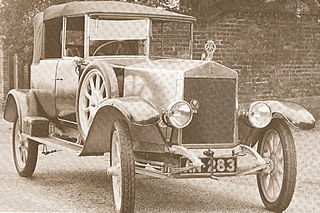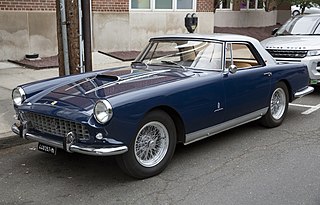
The Albert was a light car built by aircraft parts maker Adam, Grimaldi & Company and named after their Albert Embankment address. It was designed by A. O. Lord, creator of the later Loyd-Lord. It was produced from 1920 to 1924 in Vauxhall and later Chiswick, London.

The Austin 7 is an economy car that was produced from 1923 until 1939 in the United Kingdom by Austin. It was nicknamed the "Baby Austin" and was at that time one of the most popular cars produced for the British market and sold well abroad. Its effect on the British market was similar to that of the Model T Ford in the US, replacing most other British economy cars and cyclecars of the early 1920s. It was also licensed and copied by companies all over the world. The first BMW car, the BMW Dixi, was a licensed Austin 7. In France they were made and sold as Rosengarts, and in the United States they were built by the American Austin Car Company. In Japan, Nissan also used the 7 design as the basis for their first cars, although not under licence. This eventually led to a 1952 agreement for Nissan to build and sell Austins in Japan under the Austin name.

The Swift Motor Company made Swift Cars in Coventry, England from 1900 until 1931. It grew progressively from James Starley's Coventry Sewing Machine Company, via bicycle and motorised cycle manufacture. The cars ranged from a single-cylinder car in 1900 using an MMC engine, through a Swift-engined twin-cylinder 7-horsepower light car in 1904, and a 3-litre model in 1913. After the First World War a successful range was sold during the 1920s, but the Cadet of 1930 was its last vehicle as it could not compete economically with volume manufacturers such as Ford and Morris Motors.

The Citroën Type A was produced from June 1919 to December 1921 in Paris, France. It was the first car Citroën made. 24,093 were built.
Morris Cowley was a name given to various cars produced by Morris from 1915 to 1958.

The Rolls-Royce 10 hp was the first car to be produced as a result of an agreement of 23 December 1904 between Charles Rolls and Henry Royce, and badged as a Rolls-Royce. The 10 hp was produced by Royce's company, Royce Ltd., at its factory in Cooke Street, Hulme, Manchester, and was sold exclusively by Rolls' motor dealership, C.S.Rolls & Co., at a price of £395. The 10 hp was exhibited at the Paris Salon in December 1904, along with 15 hp and 20 hp cars and engine for the 30 hp models.

Dante Giacosa was an Italian automobile designer and engineer responsible for a range of Italian automobile designs — and for refining the front-wheel drive layout to an industry-standard configuration. He has been called the deus ex machina of Fiat.

The Citroën Type C was a light car made by the French Citroën car company between 1922 and 1926 with almost 81,000 units being made. Known as Citroën 5HP or 5CV in France and 7.5HP in Britain, it was the second model of automobile designed and marketed by André Citroën, between 1922 and 1926. It followed the 10HP "Type A " (1919), then 10HP "B2" (1921); they were the first European mass-produced cars.
The Rover 8 was a small single-cylinder 8 hp 1327 cc car made by the British Rover car company. It was Rover's first production car. It was remarkable for being supported by a backbone chassis rather than a conventional ladder frame. The first model was manufactured from 1904 to 1912. A Daimler-Knight sleeve valve engine option was available on the original model in 1911 and 1912.

The MG 14/28 Super Sports is a sports car that was launched in 1924. It was the second line of cars produced by W R Morris's MG company. The first line of cars were 1548cc Morris Oxfords fitted with a two-seater body supplied by Charles Raworth & Sons of Oxford. They were built at first in small premises in Alfred Lane, Oxford moving in 1925 to a larger site shared with Morris Motors Limited radiator factory at Bainton Road, Oxford. The badge on the front of the car still read Morris Oxford, MG badges were not to appear on the car's nose until 1928 but they did appear below the Morris badge on the honeycomb of the last of the 14-28 cars which had flat nose radiators.

The Rolls-Royce 15 hp was one of four cars to be produced as a result of an agreement of 23 December 1904 between Charles Rolls and Henry Royce. Badged as a Rolls-Royce, the 15 hp was produced by Royce's company, Royce Ltd., at its factory in Cooke Street, Hulme, Manchester. It was sold exclusively by Rolls' motor dealership, C.S.Rolls & Co., at a price of GBP500. The 15 hp was exhibited at the Paris Salon in December 1904, along with the 10 hp, 20 hp and engine for the 30 hp models, but as the new three-cylinder engine was not ready the chassis was incomplete.
The Rolls-Royce 20 hp was one of four car models to be produced as a result of an agreement of 23 December 1904 between Charles Rolls and Henry Royce. Badged as a Rolls-Royce, the 20 hp was produced during 1905 and 1906 by Royce's company, Royce Ltd. at its factory in Cooke Street, Hulme, Manchester. It was sold exclusively by Rolls' motor dealership, C.S.Rolls & Co., at a price of GBP650. The 20 hp was exhibited at the Paris Salon in December 1904, along with the 10 hp, 15 hp and engine for the 30 hp models.

The Lancia Trikappa is an automobile produced by Lancia between 1922 and 1925. It was a luxury car, offered as the flagship of Lancia's production. The Trikappa 4.5-litre V8 is notable as the first of Lancia's narrow V engines, a distinguishing feature the manufacturer only abandoned in the 1970s. The car was offered as a bare rolling chassis, as torpedo or 6-seater coupé de ville. In total 847 were manufactured.
The Palmerston was a British car made by the Palmerston Motor Company based in Bournemouth, England between 1920 and 1923.

The Vauxhall 30–98 is a car manufactured by Vauxhall at Luton, Bedfordshire from 1913 to 1927. In its day, its best-known configuration was the Vauxhall Velox standard 4-seater with open tourer body. Vauxhall's own description was the 30–98 hp Vauxhall-Velox sporting car. The 30–98 is also known to enthusiasts by Vauxhall's chassis code E.

The Warren-Lambert Engineering Co. Ltd. was a British automobile manufacturer that was established from 1912 to 1922 in Richmond, then in Surrey. A. Warren Lambert, was an agent for Morgan cars in Putney which he also raced. In 1912 he designed and started to manufacture a two-seat four-wheel cyclecar from premises in Uxbridge Road, Shepherd's Bush. It was well received and around 25 cars a week were being made.

The "bullnose" Morris Oxford is a series of motor car models produced by British manufacturer Morris from 1913 to 1926. It was named by W R Morris after the city in which he grew up and which his cars were to industrialise.
The Singer Ten name was used for several automobiles produced by Singer Motors between 1912 and 1949. The "Ten" in the name referred to the taxation horsepower rating in the United Kingdom.

The Vauxhall Light 6 is an automobile which was produced by Vauxhall in the United Kingdom from 1933 to 1938.

The Ferrari 250 GT Coupé represented a series of road-going, grand touring cars produced by Ferrari between 1954 and 1960. Presented at the 1954 Paris Motor Show, the 250 Europa GT was the first in the GT-lineage. The design by Pinin Farina was seen as a more civilised version of their sporty Berlinetta 250 MM. Series built cars were an answer to the wealthy clientele demands of a sporty and luxurious Ferrari Gran Turismo, that is also easier to use daily.















